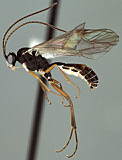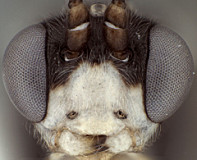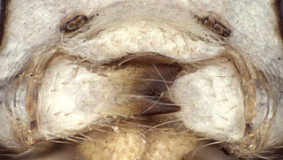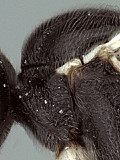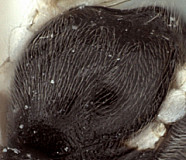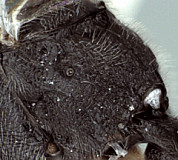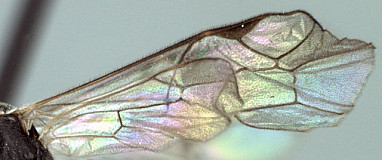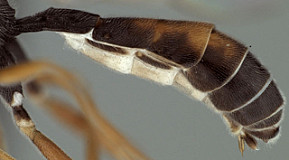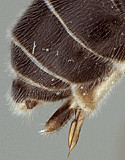Clypeus (Fig. 2) usually narrow, with surface finely punctate; blunt, thickened at least medially, usually fairly sharp laterally; ventral margin varying from evenly but weakly convex to somewhat truncate medially and angled upwards laterally as in Fig. 2; epistomal sulcus narrow, distinct, often sharply impressed; clypeus in profile weakly bulging. Inner eye margins parallel. Malar space (Fig. 2) varying from about 0.5 to1.0 times basal width of mandible; malar sulcus absent. Mandible (Fig. 3) broader and tapering over basal 0.5, apical 0.5 parallel-sided; dorsal tooth usually broader and either equal in length to ventral tooth or very slightly longer; ventral margin distinctly carinate. Maxillary palp shorter than or equal to height of head; antenna (Fig. 1) about equal in length to body, first flagellomere usually short relative to species in genera such as
Mesoleptidea and
Hadrodactylus. Ocelli small to moderate in size, diameter of lateral ocellus usually less than distance from lateral ocellus to eye. Hypostomal carina meeting occipital carina distinctly above base of mandible; occipital carina complete dorsally. Epomia present, though sometimes weak and somewhat obscured by adjacent sculpture. Epomia absent or obscured by surrounding sculpture. Epicnemial carina usually reaching anterior margin of mesopleuron, but not in several males of one of the four species examined. Notaulus (Fig. 4) present usually as a distinct, sculptured impression on anterior declivity, becoming a little weaker and more shallow on disk, but converging posteriorly into shallow median depression at posterior margin of mesoscutum. Groove between propodeum and metapleuron absent to very weakly indicated, not u-shaped as in pionines; pleural carina present, but all carinae often obscured by dense propodeal sculpture in the species examined (Fig. 6); median longitudinal carinae, when visible, forming broad petiolar area posteriorly, narrowing anteriorly. Legs (Fig. 1) with apical margin of mid tibia expanded into a tooth that is not quite as well-developed as that of fore leg; apical comb on posterior side of hind tibia weakly developed; posterior hind tibial spur 0.4-0.55 times length of hind basitarsus; tarsal claws not pectinate; fifth tarsomere of hing leg normal, not unusually elongate (relative to fourth) (Fig. 1). Fore wing (Fig. 7) with areolet absent; stigma moderately broad, Rs+2r arising at or very near midpoint. Hind wing (Fig. 7) with first abscissa of CU1 usually about equal in length to 1cu-a, distinctly longer in at least one species. T1 varying from relatively slender (Figs 8, 9) to somewhat broader: very gradually to more strongly expanding posteriorly, respectively; ventral margin weakly curved in profile; dorsal carinae present, varying from low, barely extending to level of spiracles to distinctly elevated and extending at least 0,75 times length of T1 as in Fig. 9; basal depression at dorsal tendon attachment shallow; dorsal-lateral carina complete between spiracle and apex of T1; spiracle often placed basad midpoint of T1 (Fig. 8); glymma absent. S1 not extending to level of spiracle. T2 thyridium readily visible in at least some species. T2 and T3 at least partially fused (suture distinct, but the two tergite not movable relative to one another. Laterotergites of T2 and T3 separated by creases from median tergite. Ovipositor and sheath (Fig. 1) straight, ovipositor with distinct dorsal, subapical notch.
The above description is considerably modified from Townes (1970), and based on numerous specimens in the Texas A&M University collection.

